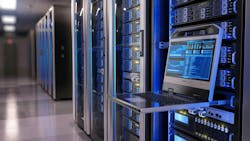Balancing the Environmental Impact of Data Centers in the Age of AI
In recent years, AI has transformed numerous industries, streamlining operations and fostering innovations at an unprecedented scale. However, this rapid advancement of AI comes with significant environmental costs, primarily due to the substantial energy required for powering AI systems.
Data centers need a lot of energy to keep their facilities up and running at peak capacity around the clock. In fact, current estimates place data centers at consuming nearly 3% of the world’s total electricity, which could nearly double by 2026 from cryptocurrency mining and AI. AI alone could account for 3% to 4% of global power demand by 2030.
As this hike in AI and computing power continues, data centers that house them face a colossal challenge of meeting the soaring power demands without compromising on energy sustainability. While legislation like the Inflation Reduction Act presents opportunities for AI data centers to operate sustainably, with incentives like tax credits for carbon reduction efforts and investments in renewable energy and battery storage, it does not address the challenge of increasing power demand and associated strain on utility infrastructure. The increased power needs of AI technologies require smarter and more adaptable ways to build and operate data centers efficiently and sustainably.
Leveraging AI in the Data Center
The role of AI in the context of data centers is crucial for addressing the increasing demand for energy and it is important for utilities to understand that this challenge requires a balanced approach, considering both the supply and demand sides.
On the supply side, data centers should aim to procure energy in the most cost-effective manner while ensuring reliable storage and processing resources for their customers. Integrated ‘renewables plus battery storage’ systems are already helping data centers reduce the cost of energy consumption. With these systems in place, data centers can also explore opportunities to sell excess power back to the grid during times of higher wholesale prices, which can be profitable for them. A good example of this is the peak discharging of battery storage recently when real-time energy prices climbed from under $8 to around $5000 within 4 hours and then dropped to below $100 in the next 45 minutes.
As data centers transition into more automated and adaptive management and operational systems, these hubs of technology must fine-tune their approach to cater to varied end-use demands, focusing on aspects like reliability, computational capacity, and energy consumption.
Data centers are the backbone of industrial and commercial sectors, where they must tailor their resource allocation to meet varying degrees of criticality. Mission-critical operations, like chip design for instance, cannot afford the slightest hiccup and require a heightened level of computational reliability unlike less critical tasks such as bitcoin mining. By flexibly adjusting resources, scaling down when necessary, data centers can maintain a consistent and dependable service for these vital systems.
The contrasting computational demands between training groundbreaking AI models and deploying them post-training exemplify the resource elasticity data centers must manage. Through intelligent forecasting, data centers can learn to dynamically manage hardware resources, like GPUs and CPUs, thereby not only catering to computational needs but also reducing the environmental footprint of their customers.
As awareness of the environmental impact of digital services grows, so does the push for energy efficiency. Organizations and end-users are more mindful of their energy use, especially concerning carbon emissions. In the future, organizations may have more ambitious net-zero carbon goals, some even setting daily, not just annual, targets. By optimizing energy use and ensuring adherence to these stringent reporting standards, data centers can help customer expectations but also champion eco-friendly practices.
Using AI to manage AI’s energy footprint
AI is not only a consumer of energy but can also be used to dynamically manage energy usage. To meet the evolving demands of renewable energy, utilities must deploy a digital strategy that leverages tools like AI and analytics to optimize data center operations by reducing their overall energy consumption, improve demand forecasting, and assist with grid management. What we have found is that utilities don’t have a problem of not having enough data; their problem is managing the data they have so that they can use it efficiently and effectively to generate value for customers and shareholders.
The roadmap to a future where power demand, data center placement, and renewable energy requirements align remains indistinct. The issue is complex, but technology offers solutions to navigate these challenges, guiding us towards a sustainable and well-powered future.
About the Author
Supratik Chaudhuri
Supratik Chaudhuri, Power and Utilities Lead at Publicis Sapient.
